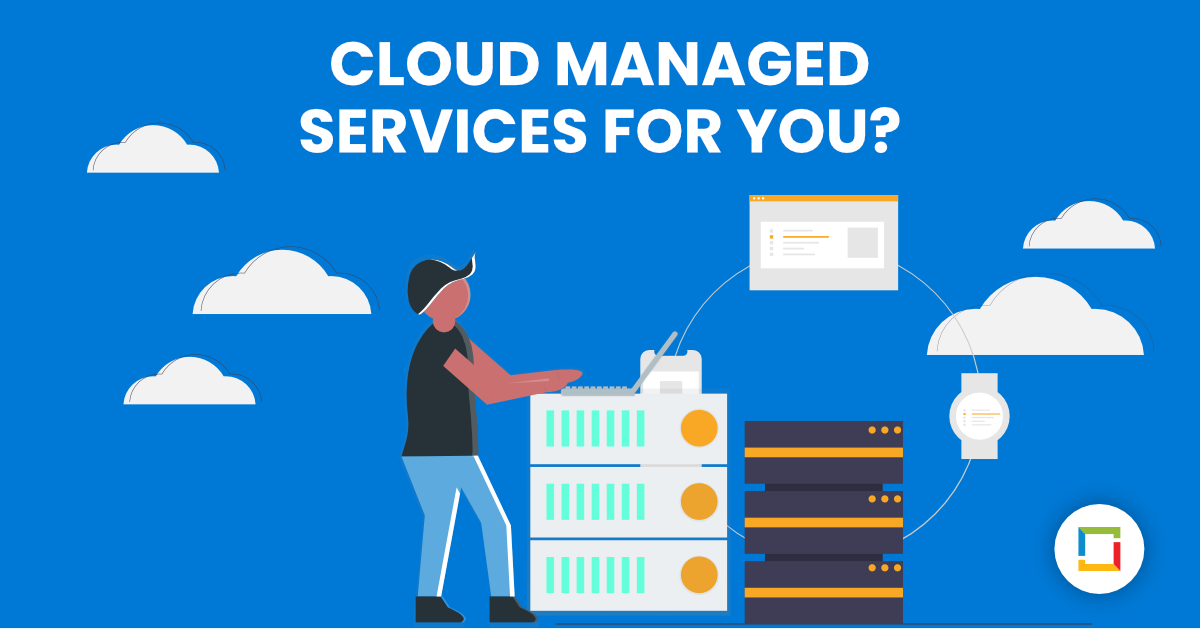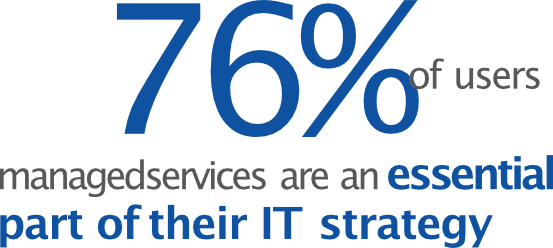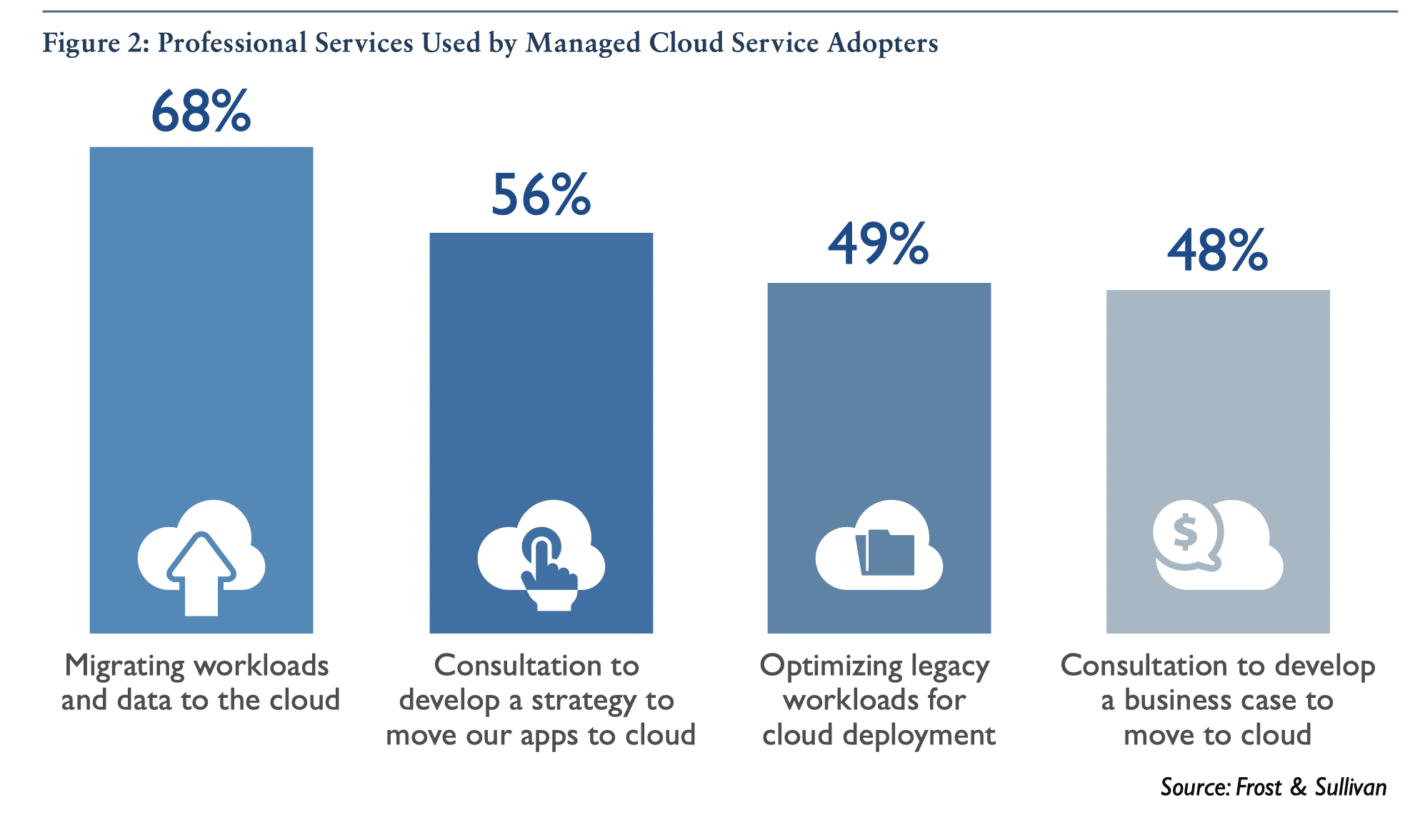Introduction
As they prepare their companies to thrive in the digital era, IT executives are transforming their own organizations and resources. To optimize application delivery and support business goals for speed, agility, and innovation, they are deploying new applications in a private or public cloud environment.
Existing applications are also coming under scrutiny, as IT leaders seek to enhance their long-time critical workloads with benefits such as automated scaling and ease of integration. Consider a complex, mission-critical ERP system such as SAP, the workhorse that supports operations for many enterprises. According to a recent Frost & Sullivan survey, 26% of US-based enterprises have deployed SAP’s modern, cloud-based S/4HANA system for at least some of their SAP workloads; another 44% say they plan to do so.
But simply deploying some workloads on a cloud platform is not sufficient to meet escalating business needs and competitive challenges. As they consider their far-reaching legacy ERP systems, IT leaders are challenged to determine where to invest for maximum return. Which workflows and applications should be moved first, and which should be left on-premises? Which workloads require refactoring, and which can remain in “legacy” mode? How can they reduce the management burden while still ensuring optimal performance and delivery? How can they ensure security and compliance requirements are met in a cloud environment?
For assistance, an increasing number of enterprises are turning to cloud managed services providers for their critical ERP workloads. A managed services provider will lead the migration effort, ensuring that data and applications are moved with minimal business disruption. The provider can enable you to optimize workloads and add efficiencies without necessarily doing a complete “rip and replace”; for example, integrating legacy SAP data with your new S/4HANA environment. And the right managed services provider will provide ongoing management of your environment, enabling your team to focus on strategic business initiatives.
Can your business benefit by engaging a cloud managed services provider for your SAP or Oracle workloads?
Among businesses that have already migrated, 76% say cloud managed services are an essential part of their IT strategy, and they cite benefits including cost reduction, greater flexibility and efficiency, improved speed to market, and increased security and compliance.
We show how to start quantifying business benefits in your own company, as well as offer user tips on selecting the right managed cloud service provider.
About Managed Cloud Services
Managed cloud services create a partnership between the enterprise and the service provider, in which the provider contributes cloud technology, infrastructure, and expertise; and the enterprise retains oversight capabilities to ensure that business goals are met.
Many businesses—60% according to recent Frost & Sullivan research—have adopted managed cloud services as a way to ensure optimal function of enterprise applications within a secure environment. Furthermore, adopters are most likely to consider managed services as strategic investment, a way to achieve their business goals.
A clear benefit to utilizing managed cloud services is that workloads do not have to be cut-over all at once; instead, the deployment of specific workloads can proceed at a pace that is suitable to the culture and priorities of the enterprise.
Among current managed cloud service users, only 6% have deployed all their SAP or Oracle workloads. 34% have deployed more than half of their workloads; and 31% have deployed a quarter or less. While the goal for many is to realize maximum benefits by eventually migrating their entire portfolio to the managed services provider, the ability to try out the managed environment with a few workloads is important to prove the concept and overcome concerns.
How Managed Cloud Services Help Businesses Achieve Business Goals
Users of managed cloud services cite a number of benefits that came with the transition to managed services. As shown in Figure 1, the services enable IT organizations to run SAP or Oracle workloads more efficiently (e.g., reduced maintenance burden; reduced capital costs), and also enable the business to achieve strategic business goals (e.g., faster service delivery, optimized application performance, improved customer service).
But how much are these benefits worth to a business? Can they provide sufficient Return on Investment (ROI) to justify moving your SAP or Oracle workloads to a managed cloud services provider? To find out, the next step is to create a business case.
Building a Business Case : Assessing ROI for Cloud Managed Services
With limited staffing and budget resources, you need to ensure your investments will pay off. That requires an analysis that includes:
- Direct and indirect costs of your current operational model (whether on premises or self-managed in a public cloud)
- Direct and indirect costs of cloud managed services, as provided by your provider
- Valuation of additional business benefits associated with cloud managed services, including opportunity costs associated with freeing up staff time; cost and productivity efficiencies associated with speed to deploy functionality; lower costs and higher revenue associated with improved customer, partner, and employee satisfaction; and so on, depending on the workload
By calculating the return (in business value) compared with costs for each model, you can derive an ROI that is likely to convince stakeholders that managed cloud services make sense.
Getting Started: Choosing a Workload
The greatest business value will likely come from moving all or the majority of your ERP workloads to a managed cloud provider. However, to start off your planning, it may make sense to attack the challenge one workload at a time. Just as you would assess any other workload for optimal deployment in your hybrid IT environment, you should start by understanding what the workload does, and the value it brings to the business.
SAP and Oracle workloads are complex, comprising multiple applications and workflows. Start with one or a few discrete workflows that are likely to provide you with a quick win.
STEP 1: Work with LoB to Identify Workloads for Potential Migration.
With the advent of collaborative IT processes and the service broker model, line of business (LOB) organizations wield considerable influence over technology decisions. And no wonder: in the digital era, every business function relies on technology to manage, measure, and perform their work functions. In fact, 66% of survey respondents say a significant challenge to implementation of managed cloud services is that “LoB resists giving up control over their workloads.”
To gain LoB support, you need to educate your business colleagues about the value a managed service provider can bring to their workloads. Talk from the perspective of business benefits (for example, improving application performance and helping them predict and manage costs), rather than IT benefits (like reducing maintenance burden). To start the dialogue, ask LoB stakeholders and users about SAP or Oracle workflows they are struggling with, and how the workflow may be failing to meet business needs. Likely responses are:
- System is too slow
- Latest updates aren’t implemented quickly
- Costs are too high or unpredictable (when charged back to business unit)
- Reliability/availability issues (planned and unplanned outages)
- Security/compliance risks
- Lack of visibility into data, due to disparate data in multiple locations
Next ask your LoB colleagues to help quantify how improvement in the workflow would make a difference to their business goals or key performance indicators. Depending on the workflow, examples may include the following:
- Faster transactions can translate to higher employee productivity or even higher customer satisfaction (and thus better retention)
- Access to latest updates and technologies (e.g., analytics) can provide a competitive advantage, resulting in higher brand equity and greater market share
- Greater reliability/availability can mean more efficient supply-chain operations, thus reducing costs and increasing speed-to-market
- More dependable security parameters and easy access to compliance reports mean less business risk, lower costs, and eliminates the need to hire security experts on your staff
STEP 2: Compare Costs
In any business case, you need to derive ROI. Start by looking at all the cost components for operating your SAP or Oracle workload in your current environment and via managed cloud services.
- For your current, on-premises deployment, calculate capital and labor costs to run, manage, and update the workflow. This includes infrastructure investments, amortized according to your company’s accounting policies. Be sure to include the operating costs associated with hiring and maintaining expertise in specialized systems, including ongoing training.
- Consider lost opportunity costs associated with your current on-premises model. When your IT resources are consumed with routine maintenance tasks, what else is being left undone or delayed? (Note that 55% of managed services users cited “reallocating staff” as a benefit.) Estimate the value of time; for example, how does a delay in rolling out a new product impact revenue? How does poorly maintained infrastructure add to costs?
- Now, obtain quotes from managed services vendors. Be sure you know exactly what tasks you will be handing off to the provider (thus reducing your own management burden), and what tasks can be made moot. For example, the provider may supply security and compliance reports; automatically apply patches and upgrades; handle trouble-tickets; simplify budget management by offering predictable costs.
You can start to calculate total ROI by looking at costs to run the same workloads in the two environments. When all costs are considered, most managed services customers find their costs are reduced when they engage a managed services provider.
STEP 3: Comparing Business Value
But with digital transformation, your business has more at stake than just running the workload inexpensively. A straight cost comparison, as shown in Step 2—as comprehensive as it may be—does not adequately capture how each deployment option fits with your corporate vision. So, to derive a true ROI, the “return” must take into account each model’s contribution to the achievement of your strategic business goals.
In many cases, you may find that the fast pace of business, and need to leverage the latest technologies, is not well-supported by legacy applications and infrastructure. In fact, you may determine that you must migrate critical SAP and Oracle workloads to the cloud in order to meet business goals such as:
- Flexibility—The fast-paced economy requires businesses to be agile, responding to market or competitive conditions quickly. That requires flexible infrastructure. 70% of managed services users said managed services enabled them to deliver services and applications faster.
- Efficiency—Businesses are looking to optimize processes, driving out cost and resource inefficiencies. 66% of managed cloud service users said they were able to improve and optimize performance of SAP or Oracle workloads. 57% of users said managed services enabled them to reduce the hardware and software maintenance burden.
- Innovation —To avoid disruption and maintain competitive differentiation, businesses feel pressured to continually innovate. 55% of managed services users say they were able to refocus staff on higher-value work.
- Integration with advanced technology—Leveraging innovative technologies, including artificial intelligence, is important to businesses. 69% of managed service users said an important attribute in selecting a managed service provider is “integrated intelligence and analytics functionality.”
- Security/Compliance —You can’t compromise on security and compliance. But protecting your data and applications from the latest threats takes more time, and requires more expertise than most IT staffs can afford. 76% of managed services users say they achieved improved security and compliance reporting by selecting a managed services provider with strong expertise in security and compliance.
In most cases, these strategic goals are not well supported by your current on-premises deployment of SAP or Oracle, but should be supported by the right managed cloud services provider.
STEP 4: Consider Value-added Services
Ideally, migrating to cloud managed services means more than simply getting someone else to do the same old functions on the same old workloads as you do today. You should expect the provider not only to optimize workload deployments, but also introduce best-practices for migrating and managing your critical workloads.
Businesses that have found the greatest success look for cloud managed service providers that offer professional services and advice, as shown below in Figure 2.
In some cases, the value-added services obtained from the managed services provider directly offset considerable time and resource investment from your own staff. For example, the top-used service, “migrating workloads and data to cloud,” is not restricted to SAP and Oracle workloads; migration is a top-cited challenge for every cloud implementation. By engaging the managed cloud service provider to perform or lead the migration phase, enterprises not only free up their own resources (personnel and technology) from a difficult and risky task, but they generally can expect the migration to be completed faster and less expensively, with fewer glitches and bugs and less business disruption than if they had attempted to do the job themselves. Those factors need to be taken into consideration as part of the business case analysis.
In other cases, the professional services engagements encompass functions that the enterprise is poorly equipped to do on its own, because of lack of expertise and experience. Services such as developing a business case or migration roadmap, and optimizing legacy workloads, have a real impact on business operations, primarily in terms of increased efficiency and decreased costs—although the benefits may be difficult to quantify.

- Recommendations that take into account the technology the customer already owns (cited by 27% of managed cloud service users)
- Understanding current trends and challenges in the industry (cited by 26%)
- Providing ways to optimize legacy workloads (24%)
- Providing access to thought leaders who help them understand how to plan for future protection (23%)
By including all these costs and considerations into your business case analysis, you will likely find that managed cloud services offers an attractive ROI, while also supporting your company’s longer-term business goals.
Choosing The Right Cloud Managed Services Provider
Not all cloud managed services providers are alike. To maximize your ROI and derive the greatest value from your managed services investment, you need to select a managed services provider that is able to deliver on your needs. Making a choice is not easy: among businesses surveyed by Frost & Sullivan, 77% cited “finding the right partner” as a top challenge to their managed services initiative.
For advice in what to look for in selecting a managed cloud service provider for your SAP and Oracle workloads, the best source may be current managed services users, over 90% of whom say they are “extremely” or “very satisfied” with their provider. Top-cited criteria include:
- Integration with in-house applications (cited by 82% of managed services users): Far-reaching SAP and Oracle systems extend into many areas of the business, and are accessed by many applications and users. Enterprises expect their managed services provider to utilize a platform that enables SAP and Oracle workloads to share data, leverage and integrate with other business applications, whether in the premises data center or in the public cloud.
- Global capabilities (cited by 76%): In the worldwide economy, enterprises are likely to have employees, partners, and customers worldwide. To comply with stringent and evolving data sovereignty laws, they require a managed cloud provider that has a global network of cloud centers in the geographies where they do business. Furthermore, they need a provider that delivers a consistent level of service across all data centers worldwide.
- Secure platform backed by service level agreements (cited by 75%): Evolving security threats remain a top concern, and it is difficult for enterprises to cede control of their environment without assurances. The provider should be a recognized industry leader in security technology, with a platform that embeds the latest technologies.
- High availability/uptime service level agreements (cited by 74%): Business is conducted around the clock, and it’s unlikely that your mission-critical SAP and Oracle applications can afford to go down, even for routine maintenance. The right managed services provider will configure your workloads for the availability levels you need, and back their assurances with SLAs.
- Close relationship with SAP/Oracle (cited by 71%): Enterprises that manage their own legacy ERP workloads struggle to keep up with maintenance activities—e.g., patching, upgrading, and custom integrating the software to keep up with the latest releases. You should expect more from your managed services provider than “keeping up.” Look for a provider that has a long and close relationship with your ERP vendor. Such a provider will be privy to the vendors’ roadmaps, and may participate in joint engineering projects or beta tests. When the provider is able to prepare for updates well in advance of launch date, your company benefits from being early to market.
- Integrated intelligence and analytics (cited by 69%): The need for greater business insight is one of the top reasons for modernizing legacy SAP or Oracle workloads. Enterprises understand that mission-critical operations generate tremendous amounts of potentially valuable data that can lead to greater process efficiencies, customer insights, or more. The right managed cloud service provider will run your workloads on an intelligent platform that is designed to leverage the latest analytics capabilities, including artificial intelligence and cognitive compute.
- Services to ease migration to cloud (cited by 68%): Managed services users who cited “migration services” as a top criterion in selecting a provider likely put their money where their mouth is; the same percentage (68%) said they actually have subscribed to their provider’s migration services for SAP or Oracle workloads.
Conclusion
Among businesses that have yet to migrate to managed cloud services, concerns about costs rank high (cited by 65%). At a time when budgets are under scrutiny, such businesses tend to look at managed services fees as an unwelcome “extra” line item.
But a cost-benefit analysis shows a different result. When businesses migrate to managed cloud services, they are likely to see a reduction in overall costs. Fifty-four percent of managed cloud users say they reduced capital expenses; 40% said they would be able to reduce labor costs; and 49% said they were able to shift costs from the capital to the operating budget.
Even more valuable to 68% of respondents, managed cloud services enabled them to more predictably manage the costs associated with SAP and Oracle workloads.
To determine if managed services are right for your business, you need to do a thorough ROI analysis that considers not only the topline fees, but the offset savings associated with hardware and software maintenance.
More importantly, your analysis must include the business value associated with benefits such as optimized application performance, faster time-to-deployment, security assurances, innovative or strategic solutions introduced by reallocated IT staff, simplified compliance reporting, and access to advanced analytics capabilities.
The complexity and pace of transformative technology means that there’s no reason for any IT organization to “go it alone.” By understanding how you may benefit from migrating your critical SAP or Oracle workloads to the right managed services provider, you can give your company the best chance for success.
Looking for an experienced Managed Cloud Services Provider in Dubai? Schedule your Free, No-Obligation 30 Minute Cloud Strategy Session Today!




